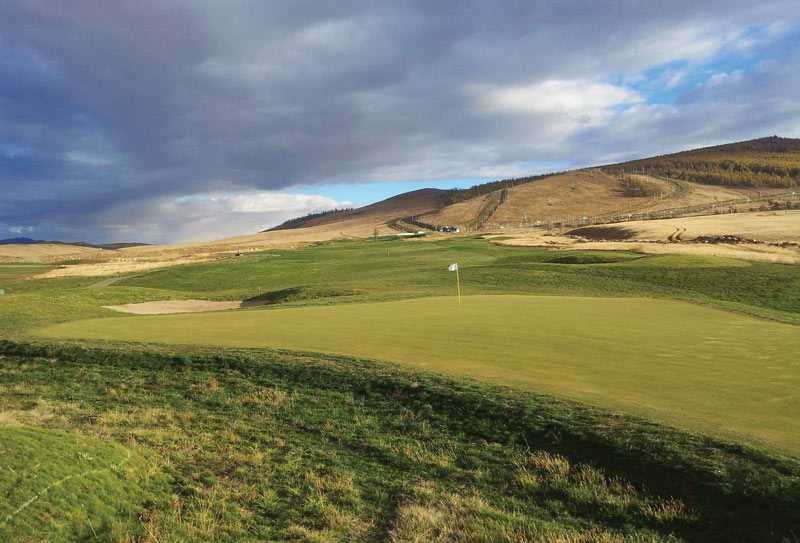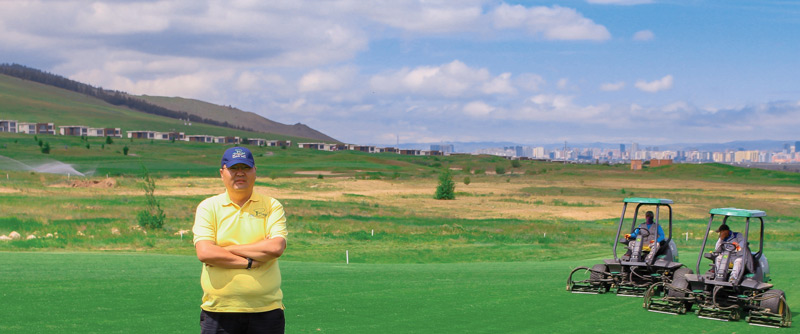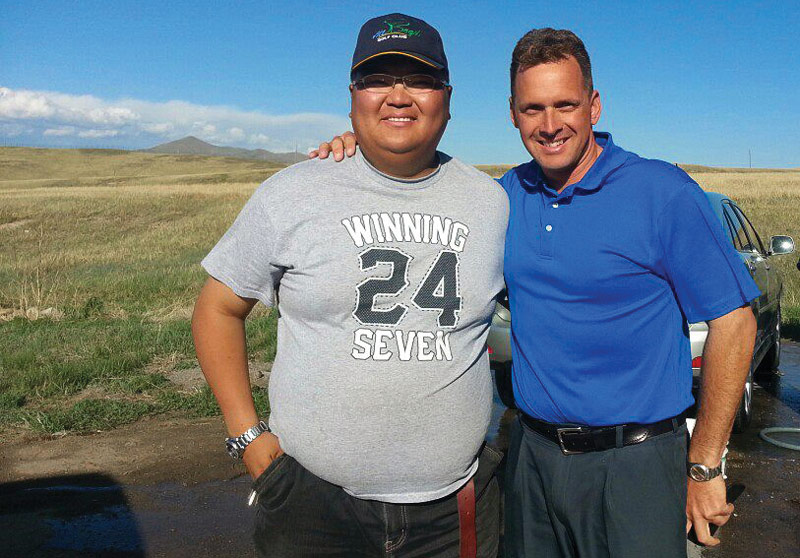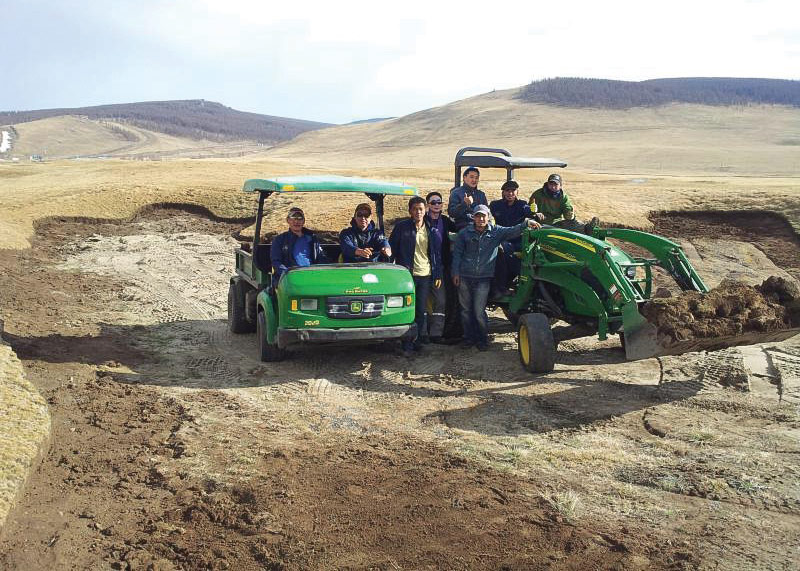
Mount Bogd Golf & Country Club is home to the only all-grass, international-standard golf course in Mongolia. Greens are T-1 creeping bentgrass, known to be “the forgiving bent.” Photo courtesy of Jason Chennault
If ever there were to be a GCSAA-affiliated chapter in Mongolia, its meetings would be quite lonely.
In all of Mongolia — the 19th-largest country in the world by area but the 100th-and-change (depending on who is doing the counting) in population, making it the most sparsely populated sovereign nation in the world — there is just one real-grass, international-standard golf course. Overseeing that lone course is Ariunbold Damba, a 38-year-old married father of three and a proud card-carrying member of GCSAA.
But Damba is quick to add a caveat to his claim of being the only association member in the country sandwiched between Russia and China: “Yet!”
Damba, in his first year of his second GCSAA membership (he belonged for a few years starting in 2012 but let his membership lapse), has served as superintendent at Mount Bogd Golf & Country Club in Ulaanbaatar, Mongolia, since 2012. Holder of a superintendent’s certificate from Rutgers University, Damba has worked for Sky Resort Co. — Mount Bogd’s owner — since 2008 and has been at the course since construction began.
No easy growing
“It’s an absolute challenge to maintain golf grass in a country where the winter temperature drops as low as minus 22 to minus 33 at nights,” says Damba, whose course lies at the base of Mount Bogd at an elevation of 4,265 feet, about 8 miles southeast of the Mongolian capital of Ulaanbaatar. “One of the many (visiting) superintendents from the USA once said to me, ‘If a grass survives a Mongolian winter, it will survive anywhere else on the globe.’ I recall that from time to time.”
Chances are, Damba recalls it every spring. He says the golf season generally runs from early May to the middle of October. “When to open and when to close is the decision made by Mother Nature,” he says. “We just follow.”

Ariunbold Damba has been the superintendent at Mount Bogd Golf & Country Club since 2012. In the offseason, the resort caters to skiers, and Damba’s role shifts to ski operation manager. Photo courtesy of Ariunbold Damba
Ulaanbaatar bills itself as the coldest capital city in the world, and with good reason. Its annual average temperature is below freezing: 27.7 F (minus 2.4 C). Reykjavik, Iceland, is a relatively balmy 39.7 F (4.3 C). Because of the climate and lack of established golf courses, the staff at Mount Bogd went through a lot of trials and errors.
“We observed. We tried different methods. We did a lot to bring our grass to adapt to the local climate,” Damba says. “But one thing I always say: Never say 100%. This means, even if you did everything as needed, still, it is Mother Nature who says the last word. I can never promise my boss 100% of survival. That is the bitter truth here in Mongolia.”
The other side of that truth, however, is that the brutality of Mongolia’s winters helps accentuate its summers.
“We have a few advantages being a golf course in Mongolia against those in Southeast Asia,” Damba says. “The most important advantage is my worst enemy No. 1 — the weather. The enemy during winter camouflages into a blessing hand during summer. Summertime in Mongolia is paradise — fresh and cool air.”
19 minutes of summer
Jason Chennault certainly knows all about the challenges of trying to maintain Mongolia’s only golf course. He was involved in its grow-in for about a year and helped train Damba and Damba’s staff.
“The greatest challenge for Ulaanbaatar is the temperatures just aren’t very warm for very long,” says Chennault, a globetrotting GCSAA Class A superintendent who has been an association member for 23 years. “I used to joke that summer in Mongolia is all of 19 minutes. In June the year I was there, I woke up to minus 15 Celsius, and opening was expected in July. It’s incredibly dry air as well. It was quite cold, but there’s hardly any snowfall — not enough moisture.”
Chennault says one winter he was in Ulaanbaatar, it reached minus 43 C (minus 45 F), and he states on his résumé that he has managed turf internationally in conditions from minus 43 C to 48 C (118 F). He wasn’t charged just with growing-in Mount Bogd’s golf course; he was challenged to train up the staff on hand who would maintain it once he left, and Damba — to whom Chennault refers as “Booyo,” the familiar form of his formal name, Ariunbold — was among the few with any formal training. In addition to his Rutgers education, Damba had also worked at a few golf courses in Missouri before returning to his native Mongolia.

Ariunbold Damba, left, and Jason Chennault during the early days of Mount Bogd Golf & Country Club. Photo courtesy of Jason Chennault
“The staff were working on the country’s first-ever all-grass golf course,” Chennault says. “The staff got a lot of training, because Booyo and I are pretty hands-on. Booyo is a quick study. He’s a hard worker, too. Even though he had not been on or worked on a course at the level we wanted to achieve at Mount Bogd, by me being in the field with them daily working shoulder to shoulder with them, we all learned how we would get it done with what we had to work with.
“From how to approach greens — you know, parking the vehicle and trailer some days fully on grass and other days just off the cart path — to learning about the line/direction of play and how that can help to understand mowing directions, why change mowing directions ... I mean, it’s teaching people who have never seen a golf course about the game and how what we do impacts the play daily. It’s a task, but I love it.”
Editor’s note: Tony Taylor, CGCS, who made the career leap to the Asian golf market over 20 years ago, shares management lessons learned through a different lens in A golf course superintendent abroad.
Mount Bogd was designed by Santa Rosa, Calif.-based Golfplan in 2008, and construction began that year. The process was hampered by weather, of course, as well as rocks and lack of good, accessible topsoil.
“The lack of a sand cap and, bigger issue, lack of large amounts of clean topsoil meant hard fairways that, if or when you aerate, you’ll have to accept that rocks are part of life,” Chennault says. “Sadly, we were finding rock simply out mowing, and as we got lower, we were more prone to find the edges of rock. That’s tough on reels and bedknives.”
Prior to design, Sky Resort in 2008 hired Mongolian botanist Bayasgalan Luvsandorj to set up turf variety trials. She narrowed her initial list from 70 to 20 for the field trial. Half of those were almost immediately ruled out. Greens and tees presently feature T-1 creeping bentgrass (“the forgiving bent”), and fairways are annual bluegrass.
“These professional and high-brand grasses blend into the natural fescues on our unmaintained rough areas,” Damba says, “creating a beautiful contrast. It is an absolutely stunning view during June through August and September.”
‘I can’t say there’s a tougher place’
Golfplan principal David Dale is biased, of course, but he, too, rather likes the look of the place.
“When you’re driving in, you wonder where the golf course is,” he says. “When we built the course, we cut down into the land. There are some harsh winds, so we wanted to drop the golf into the land to be able to protect the players. You’re in the Gobi Desert. You think, ‘Wow, I’m in between dunes.’ But you’re not. You’re in low areas we created. It looks like a simple plain, a soft gentle roll with a slight incline. It’s so fun to walk. It’s really neat.”
Dale recalls that it took close to three years to grow-in the course. Chennault thinks that’s a conservative view.
“My least fond memory or feeling, really, was that sometimes it seemed no matter what we tried, we couldn’t deliver what they want, when they want it,” Chennault says. “I said to (turfgrass researcher) Mike Healy, and I know it’s right, it’s a five-year grow-in, and even then, the five years is for the original seedlings. It’s a process of seeding and reseeding that will never end, I think, and protecting what you have each year is paramount.
“I can’t say there’s been a tougher place. I’ve been a lot of places. Some were tough, but not quite Mongolia tough. There’s nothing I can imagine that’s quite that hard.”


Construction began on the Mount Bogd golf course in 2008, and the course saw some play in 2011. But winterkill that offseason and the following offseason necessitated reseedings, which postponed the official opening. Photos courtesy of Jason Chennault
Damba oversees a staff of roughly 150 golf workers. They don’t get the brutal offseason off, as Sky Resort also owns the first and only “international-standard” ski resort in the country.
“My golf workers switch to ski operation during the winter season,” Damba says. “So do I. I become a ski operation manager.”
Damba says the course opened for the season in early May this year. Like the rest of the world, it has been impacted by the coronavirus pandemic.
“Winter survival of the grass was nice,” he says. “We suffered two lockdown weeks, during which my workers used to camp at the golf course site to take care of spring irrigation. But now local golfers enjoy playing on a real course, after a few months of simulator play. Last winter, no golfer, nobody, was allowed to go anywhere abroad. Usually during the winter, Mongolian active golfers travel to warm-weather countries to play golf, but not the last one. The hope is that the number of our golf tourists will catch up again.
“We used to have an increased number of golf tourists from Korea, China and Japan. The word-of-mouth advertising by Koreans used to double up the number of Korean golfers coming each year before the pandemic. You may not know how terribly hot, sticky and heavy the air in Southeast Asian countries is during June, July and August. But in Mongolia, it is natural air conditioning by fresh air, not by Freon AC. Also, as Mongolia is in a high altitude, the golf ball just flies because of the thin air. Golfers love that.”
Andrew Hartsock is GCM’s managing editor.